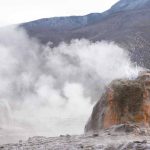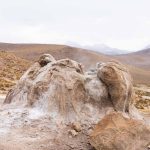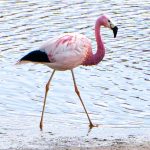They might not be the biggest geysers in the world, but when you are so close, why not have a look at this minor miracle? This indication of the brutal forces of the earth hidden underneath this valley, better known as the El Tatio geysers.
It’s goddamn early. The alarm goes off at around a quarter past four. In winter, when sunrise is later, it is not so tough. But now, in the heart of summer, we have to get up early. Catch the sunrise. Up in the valley.
There are many tourist agencies in San Pedro but in the end they all offer the same. A van picks you up at the hostal between 4.30am and 5am. At that time the French bakery opens, where every agency picks up their delicious baguettes. And then you venture off, into the wild, towards the Bolivian border in the north.
Most people still sleep the first part. But once you leave the asphalt road, that is impossible. Driving becomes the wild west, with many vans speeding side by side through the dirt road in the desert. Once every while you get a glimpse of the vast nothingness outside. You pass a small indigenous village, with some tourist accommodation run by the locals who (after lengthy negotiations) also run the access to the geysers.
The trip takes some 90-120 minutes. You are reaching a height of around 4.000 metres here already: it’s not unusual that visitors get height sickness here. One last stop to pay the entrance fee, and then all the vans finally unload.
The daylight is already aplenty there. And bubbling water everywhere. These are not the explosions metres high in the sky as you might see them in Iceland. But it is still a massive natural phenomenon to watch for yourself. Boiling water shooting up, and unleashing many minerals as well. Which explains the sulphuric smell.
The guides explain the scientific basics behind it. And that they tried to build a geothermal electricity plant here, but that was like toying with the devil. Once you stir him awake, you don’t know what to expect. So the machines for geothermal energy were left to rot.
You can sit on the stones, to feel the enormous heat hiding underneath. There are dozens of smaller and bigger wells coming through the earth’s crust. And when the sun reveals itself over the mountains, the rays produce a dazzling light. It is these photos why you had to get up so early. Because the geysers, they are active day and night.
You get maybe an hour with this phenomenon. One last picture, and that was it. A train of vans goes the opposite way, back to San Pedro de Atacama.
In the valley you finally get your French baguette, and coffee, and some delicious avocado. Not bad at all. In the desert you make detours to see guanacos and other deer walking around freely. And just past the indigenous village you make an unexpected stop: pink flamingos parading in front of you, saving you from another excursion to a place with much larger flamingo colonies.
Around noon you are back. And you think: what did we just see? And it is only midday! How much better can this day become? (better, if you take the Valle de la Luna tour which goes into the desert dunes for sunset!)












